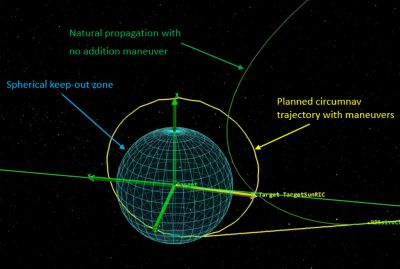ANSYS BLOG
July 26, 2023
Ensuring Safe Skies: The Importance of Passive Safety in Spacecraft Flight
Space travel has always captured the imagination of humankind, but the risks associated with venturing into the great unknown cannot be ignored. Ensuring the safety of spacecraft and their occupants is paramount in space exploration. While active safety measures play a crucial role, passive safety features and analysis are equally vital for mitigating risk. This becomes even more critical when two spacecraft are performing rendezvous and proximity operations (RPO). Let's dive into the significance of passive safety for RPO analysis and its contribution to safeguarding astronauts and valuable assets.
Designing a Close Proximity Trajectory With Safety in Mind
Depending on your role, passive safety may have several different meanings ranging from collision avoidance to structural shielding. For now, we will focus on the trajectory design and collision avoidance aspects of passive safety. When designing a close proximity trajectory, ensuring that satellites will not collide is the highest priority. This is becoming more critical as close proximity missions are increasingly more common with new satellites. While this is challenging to verify in normal circumstances, what happens when an engine goes down, communications are lost, or the satellite enters safe mode? In situations like these, it is important to understand where the satellite will go in the absence of any additional inputs, maneuvers, or otherwise. In the absence of additional maneuvers, the satellites cannot collide, but usually a safe stand-off distance is desired throughout the event. Ensuring these constraints can be a long and tedious process, but Ansys Systems Tool Kit (STK) and the Astrogator capability can help.
Astrogator has long been known as the premier orbital design engine, especially for RPO missions, and it now has a built-in tool for passive safety analysis. Introduced in the 2023 R2 release, the Passive Safety Utility in Astrogator enables you to analyze flight safety in situations in which a critical error may occur. This helps mission designers verify your passive safety requirements and validate that the satellites will not collide.
The Passive Safety Utility runs on top of an Astrogator trajectory and will validate each maneuver that you have designed as it relates to a specified target. At the end of every maneuver it will pull a state vector and propagate it forward in time. This propagation does not include any maneuvers or attitude shifts that were planned in the future, thus simulating a natural propagation with no additional inputs. This propagation can be compared against keep-out zones or conjunction requirements to verify passive safety.
Make an Automated Passive Safety Check
In the following example, we will look at applying this tool in a forced motion circumnavigation around a specified target. The following image shows the planned trajectory in yellow, the desired keep-out zone in blue, and a sample passive safety check as the curved green line.

Forced motion circumnavigation model in Ansys STK Astrogator
The trajectory shown has more than 40 maneuvers, all of which need to be checked for passive safety. The green trajectory shows a passive safety propagation for one such maneuver. In the case shown, the maneuver in question was executed, but no additional maneuvers could be executed. This resulted in the satellite drifting backwards relative to the target. The Passive Safety Utility automatically checks all maneuvers in the trajectory and allows the user to graphically switch between each result and analyze the outcome. The following image provides a sample of the passive safety interface for this mission. The tool allows the user to not only specify a target and actor of interest, but also specify particular keep-out zone sizes and shapes to meet requirements.

STK's Passive Safety Utility interface
When you run a passive safety analysis, it provides a list of outputs such as resulting minimum range to help you better understand the level of safety for each maneuver. It clearly marks when something is unsafe so you know exactly what to change in your mission design. You can also download all resulting data for use in additional analysis or tools, which can greatly reduce analysis time and help mitigate the risk of collision in operation.
Give the Passive Safety Utility tool a try today!